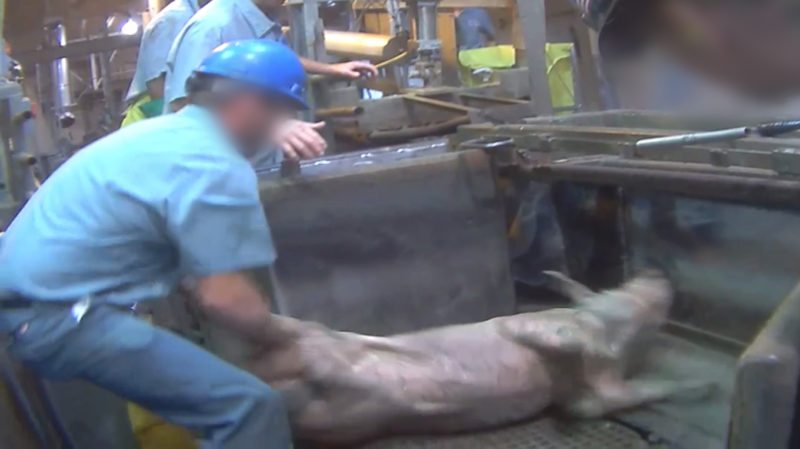As the USDA debates rolling out their high-speed pig slaughter program nationwide, the slaughter and meatpacking industries remain some of the most dangerous working environments in the US.
In a new story, The Guardian reports that in US meat plants there are two amputations a week and 17 “severe” incidents a month, which includes hospitalizations or “loss of an eye.” Workers in these plants are already at high risk for injuries, and many are immigrants who are overworked, underpaid, and denied breaks to maintain speed.
The USDA’s proposed expansion of its pilot program known as (“HIMP”) that increases the speeds of already dangerously fast slaughter lines could only put workers at higher risk. This program has been tested in 5 US slaughterhouses, but injuries to workers and cruelty to pigs is still commonplace. In 2015, former COK investigator Scott David worked inside Quality Pork Processors (QPP), a slaughterhouse that exclusively supplies to Hormel and is considered a model plant for the high-speed pilot program. There, David witnessed gut-wrenching cruelty at this facility that kills approximately 1,300 pigs every hour (that’s more than one pig every five seconds), and also penned a powerful op-ed for The Guardian about what he witnessed.
Meanwhile, under this New Swine Slaughter Inspection System (NSIS), the presence of government-trained inspectors is reduced, while slaughter lines are simultaneously sped up–saving the USDA over $6 million per year, The Guardian reports.
Under NSIS, the USDA is essentially giving the profit-driven pork industry the power to regulate its own food safety measures, but this high-speed slaughter system is dangerous for workers, animals, and consumers alike.
The Guardian reports horrifying specific injuries suffered by meatplant workers, such as a worker having to have his arm surgically amputated after it was pulled into a cubing machine during sanitation, and another being knocked off of a hydrolyzer, breaking a bone over his eye and suffering first- and second-degree burns.
Though these injuries may seem at first like freak accidents, serious injuries are common in the industry. And even workers who do not suffer these traumatic injuries still indeed suffer. According to Amanda Hitt from the Food Integrity Campaign, “Increased line speeds pose a real threat to workers. In addition to heinous injuries resulting from speed such as amputations and physical injury, workers are also at risk from injuries resulting from repeated motions. A pork plant worker may make … hard-cutting knife motions while working on a line. This repetition puts the worker at risk [of] debilitating musculoskeletal problems.” Chronic injuries like Carpal Tunnel Syndrome are all too common in meat plant workers.
This must stop: @USDA‘s dangerous proposal that would allow even faster slaughter speeds is a huge step backwards –> it puts consumers, animals & workers at greater risk. Take action today: https://t.co/T7HKl8KFTw #NotSoFastUSDA @foodinteg https://t.co/WVlz0Xr8WS
— Erica Meier (@EricaMeier) July 6, 2018
As slaughter lines speed up, the slaughter of pigs becomes even more cruel. COK’s investigator witnessed egregious acts of abuse at QPP, like pigs being improperly stunned, shocked, dragged and beaten out of view of the few government inspectors, as workers rushed to keep up with line speeds. Some pigs were even improperly slaughtered, possibly resulting in them being dropped into the scalding tank while still alive.
Dangers can also be passed on to consumers. David witnessed pigs covered in feces or pus-filled abscesses being slaughtered and processed for human consumption–still receiving the USDA inspection seal of approval.
The best way we can protect pigs is to leave them off our plates. In the meantime, the USDA needs to put the brakes on this dangerous program that jeopardizes workers, animals, and the health of consumers. If the USDA wants the pork industry to remain compliant with the bare-minimum standards of animal welfare at slaughter and workers’ right to safety, speeding up slaughter is not the way to go.
ACT NOW: Join over a quarter-million people! Stand with former investigator Scott and COK: Sign & share our petition to the USDA!


